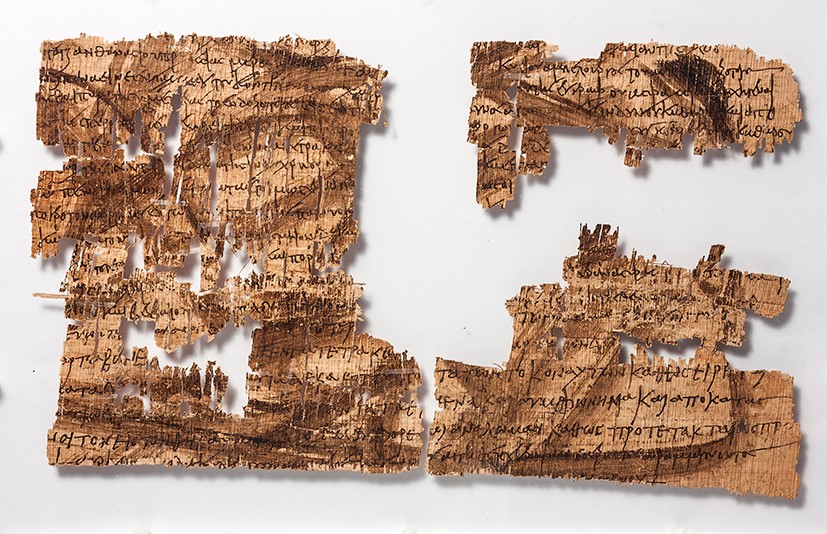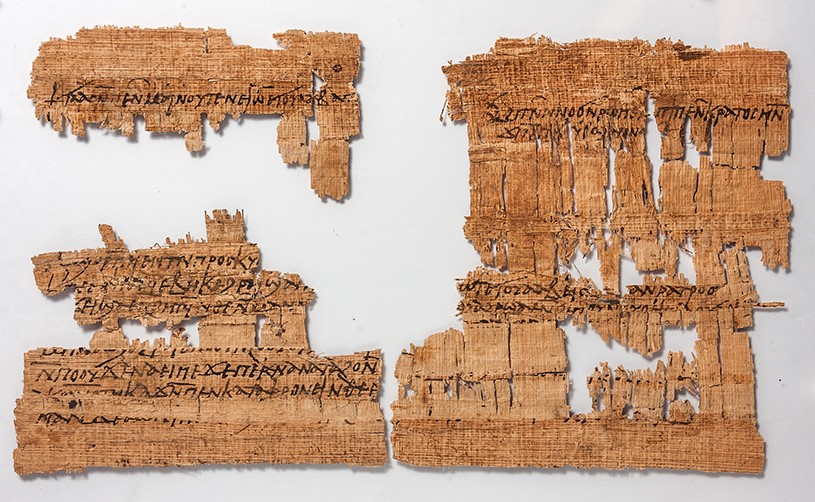Acquisition number: 1975.01
The single page is in three pieces, with many gaps. On the recto is part of a letter in Coptic, and on the verso a contract in Greek. The letter, probably of the period AD 550-650, seems to be an apology from the elders of the village of Kratos to a Bishop, and may be one of a number of items from the archives of Pisenthios, Bishop of Coptos, near Thebes in Upper Egypt. Some strips of the horizontal fibres are missing.
The contract, probably of the later part of the sixth century AD, seems to have been completely on the one page, but is made difficult to decipher by the lacunae and the ink strokes with which it was cancelled. It appears to refer to repayment of grain at harvest-time, and a payment of money, so it may be a record of a loan of seed-corn. Of its twenty lines, the first fifteen, perhaps written by a scribe, set out the names of the parties (lines 1-3), one of whom is from the Coptite Nome (the administrative division of Coptos), and the details of the transaction. In lines 16-18 one of the parties has written a brief statement of his part in the contract (the ancient equivalent of a signature). The last two lines, in a third hand, attest the consent of another party who could not write. The clearest section is the bottom right-hand corner where the words καθὼς προτέκτακται, as set out above, may be seen in line 18 and, less clearly, in line 19 ἀγραμμάτου ὄντος (on behalf of -----) as he is illiterate.
Title: Fragments of Papyrus Document - 1975.01
Acquisition number: 1975.01
Author or editor: J.R. Green
Culture or period: Later Roman Imperial.
Date: Later 6th century BC.
Material: Papyrus
Object type: Writing materials
Dimensions: 267mm (w) × 159mm (h)
Origin region or location: Egypt
Origin city: Kratos.
Display case or on loan: 6
Keywords: Later Imperial, Roman, Romano Egyptian, Inscription, Fragment, Pisenthios, Coptos
Charles Ede Ltd (London), Writing and Lettering in Antiquity (April 1975) no. 29 (ill.); J.R. Green with B. Rawson, Catalogue of Antiquities in the Australian National University, A.N.U. (Canberra, 1981) 121; A Collection of Classics from the Holdings of the Australian National University Classics Department Museum. Drill Hall Gallery, The Australian National University, 20 March - 28 April 199629 (ill.); B. Kelly, “A Late-Antique Contract in the Collection of the Australian National University Classics Museum”, Zeitschrift für Papyrologie und Epigraphik 161, 2007, 207-214.
1975.01
Fragments of Papyrus Document
Purchased. Overall size 15.9cm x 26.7cm.
The single page is in three pieces, with many gaps. On the recto is part of a letter in Coptic, and on the verso a contract in Greek. The letter, probably of the period AD 550-650, seems to be an apology from the elders of the village of Kratos to a Bishop, and may be one of a number of items from the archives of Pisenthios, Bishop of Coptos, near Thebes in Upper Egypt. Some strips of the horizontal fibres are missing.
The contract, probably of the later part of the sixth century AD, seems to have been completely on the one page, but is made difficult to decipher by the lacunae and the ink strokes with which it was cancelled. It appears to refer to repayment of grain at harvest-time, and a payment of money, so it may be a record of a loan of seed-corn. Of its twenty lines, the first fifteen, perhaps written by a scribe, set out the names of the parties (lines 1-3), one of whom is from the Coptite Nome (the administrative division of Coptos), and the details of the transaction. In lines 16-18 one of the parties has written a brief statement of his part in the contract (the ancient equivalent of a signature). The last two lines, in a third hand, attest the consent of another party who could not write. The clearest section is the bottom right-hand corner where the words καθὼς προτέκτακται, as set out above, may be seen in line 18 and, less clearly, in line 19 ἀγραμμάτου ὄντος (on behalf of -----) as he is illiterate.
Papyrus was prepared as a writing material by cutting very thin slices of the Egyptian reed Cyperus papyrus, placing two layers of them crossways on one another, beating them together and then polishing the surface. Sheets of papyrus were commonly gummed side by side to form a long scroll (Greek βιβλίον, Latin volumen). For storage this would be rolled on the rod attached at either end, and for reading the two rods were held in the hands and progressively rolled so as to expose a page at a time. The side with the fibres running horizontally (in the direction of the greatest length of the scroll) is called the recto, and was preferred for writing on. The other side, with the fibres vertical (parallel with the end rods) is called the verso. For short letters and simple contracts a piece consisting of one or two pages might suffice, and papyrus was scarce enough for discarded documents to be recycled, with new matter written on their clean side.
Most extant papyrus documents were preserved by the dry sands of Egypt in ancient rubbish dumps, and most are damaged to some extent. They contain private copies of literary works, private and official correspondence, contracts, certificates, business records and a variety of other material, mostly in Greek, but some in Latin, Coptic and other languages.
M. David & B.A. van Groningen, Papyrological Primer (4th ed., Leiden 1965) has a useful account of papyrus documents with examples and bibliography. For more general references, see above.
B. Kelly, “A Late-Antique Contract in the Collection of the Australian National University Classics Museum”, Zeitschrift für Papyrologie und Epigraphik 161, 2007, 207-214, who has published a transcription and discussion of the contract, comments further at 207 n.1 on the possible source of the piece in the collection of Sir Thomas Phillipps and origin in the so-called Pisenthios archive. He omits mention of its publication in the first edition of this catalogue and in Collection of Classics.
Charles Ede Ltd (London), Writing and Lettering in Antiquity (April 1975) no. 29 (ill.); J.R. Green with B. Rawson, Catalogue of Antiquities in the Australian National University, A.N.U. (Canberra, 1981) 121; A Collection of Classics from the Holdings of the Australian National University Classics Department Museum. Drill Hall Gallery, The Australian National University, 20 March - 28 April 199629 (ill.); B. Kelly, “A Late-Antique Contract in the Collection of the Australian National University Classics Museum”, Zeitschrift für Papyrologie und Epigraphik 161, 2007, 207-214.

